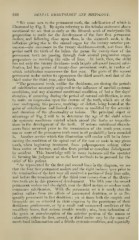Page 638 - My FlipBook
P. 638
648 DENTAL EMBRYOLOGY AND HISTOLOGY.
" We come now to the permanent teeth, the calcification of whicli is
illustrated by Fig. 2. By again referring to the tabular statement above
mentioned we see that as early as the fifteenth week of embryonic life
preparation is made for the development of the four first permanent
molars, and following close upon these, in the sixteenth week, is the
inflection giving rise to the enamel organ for the twenty anterior per-
manent—the successors to the twenty deciduous—teeth, and from this
period until the birth of the infant the germs for twenty-four of the
permanent teeth are ])assing through their several progressive stages
preparatory to receiving the salts of lime. At birth, then, the child
has not only the twenty deciduous teeth largely advanced toward calci-
fication, but has germs of twenty-four permanent teeth, in twelve of
which calcification commences the first year. The germ of the second
permanent molar makes its appearance the third month, and that of the
third molar the third year, after birth.
" The permanent teeth, unlike the deciduous, are during the periods
of calcification constantly subjected to the influence of morbid systemic
conditions, and any abnormal nutritional condition, of but a few days'
duration, if occurring during the period of coronal calcification, is sure
to make an impression upon the crowns of the teeth, which are at the
time undergoing this process, markings or defects being located at the
point of calcification and limited in extent or modified by the severity
and duration of the abnormality or lesions. The principal object or
advantage of Fig;. 2 will be to determine the age of the child when
the systemic conditions existed which caused the faults or imperfec-
tions in the development of the teeth. If serious nutritional disturb-
ances have occurred prio? to the termination of the tenth year, some
one or more of the permanent teeth must in all probability have recorded
it. Another service which this illustration will render will be in deter-
mining the condition of the apical end of the root or roots in any given
tooth, when beginning treatment, from pulp-exposure arising either
from caries or fracture, and also from partial or complete dislodgment
by accident. This knowledge will in many instances aid the operator
in forming his judgment as to the best methods to be pursued for the
relief of his patient.
"As represented by the first and second lines in the diagram, we see
that the four first permanent molars and the eight incisors have prior to
the termination of the first year all received a portion of their lime salts,
and before the termination of the third year twenty-four of the thirty-
two teeth are in this jirocess of development. The fifth year the second
permanent molars and the eighth year the third molars or wisdom teeth
commence cak^ification. With the permanent set it is rarely that the
patient suffers from the effects of interrupted dentition, as is so fre-
quently prominent in first dentition ; yet at times both the cuspids and
bicuspids are so retarded in their eruption by the persistence of their
deciduous predecessors, or by a small and contracted condition of the
maxillary bones, that serious trouble results; also, from induration of
the gums or non-absorption of the anterior portion of the ramus or
tuberosity, either the first, second, or third molar may be the cause of
much local inflammation and a febrile systemic condition, and especially


